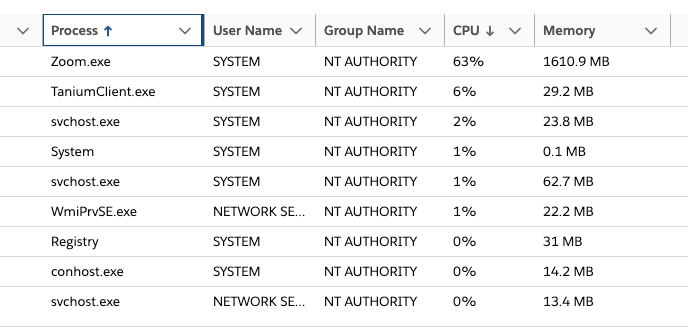Why Real-Time Data Is Essential for IT Help Desk Effectiveness
With access to real-time data, IT service desk teams can quickly and easily understand what is happening on employee devices
The job of the help desk is solving problems. To solve problems, you need data. The kind of data you have and where and how it’s stored can make all the difference in determining how quickly problems are solved.
The idea of collecting real-time data about endpoints in the enterprise might have seemed like a pipe dream to help desk teams a few years ago. But it’s possible now, and it creates new opportunities for help desks and the employees they support.
In this post, I explore the importance of real-time data for help desks. With employees more distributed than ever before, computing devices more varied, and security threats stealthier and potentially more devastating — getting real-time data about endpoints is an important capability.
Minimizing interruptions and increasing productivity
There’s a way to collect real-time data from an endpoint today. Call the employee, get their permission to launch a remote access client on their endpoint, launch the client, and stay on the phone to solve the problem.
Collecting data this way is time-consuming and expensive. It requires the full-time attention of the employee and the help desk agent. It also ties up the employee’s endpoint, preventing that person from getting other work done.
If fixing the problem requires installing new software under the help desk agent’s supervision, that process might drag on for an hour or more. It might require multiple phone calls.
The employee might have to stop work to initiate remote-access sessions multiple times. The data collected is useful, but the way it’s collected prevents the agent and the employee from working on anything else.
And, of course, once the intrusive remote-access session is over, real-time data collection stops.
Collecting real-time data about endpoints
A better approach is collecting real-time data about endpoints without interrupting employees at all. With the right kind of user endpoint management agent installed on devices, it’s possible to connect to an employee’s endpoint without launching a remote-access session.

IT Service Center gives you access to real-time data about endpoints
The agent can then report important data, such as:
- Which processes are active?
- Which processes are consuming the most central processing unit (CPU) activity?
- How is memory being used?
- How much disk space is available?
- Which versions of software are installed?
- What suspicious activity, if any, is taking place?
- What is the hardware model and configuration of the endpoint?
When help desk agents can get this information without interrupting employees, they can work much more quickly and effectively.
The agent can begin troubleshooting as soon as an employee calls for help or submits a ticket, thereby reducing Mean Time to Repair (MTTR). And they don’t need to interrupt the employee or launch an agent. They already have the information they need. That information reflects what the employee’s working on right now, so agents can troubleshoot problems while they’re occurring.
Help desk agents can access this data to solve problems proactively, resolving issues before employees even notice them. For example, if agents learn that a specific version of an application is experiencing problems, they can update all the endpoints running that version in the background.
This solution is help desk optimization: resolving performance problems before employees even realize they need to ask for help.
Asking new questions and automating more tasks
With access to real-time data about endpoints, you can ask questions that wouldn’t have been feasible before. For example, you can ask:
- What’s the most popular application in use across the organization?
- Which process is consuming the most CPU processes?
- Are employees who upgraded to a new release experiencing slower performance as a result?
- If so, how much of that slower performance is attributable to old hardware?
- Which endpoints have hardware that’s so old it should be replaced?
- Which endpoints are particularly vulnerable to new security threats?
Without access to real-time data on endpoints, collecting answers to questions like these would be a monumental undertaking. It could involve days or even weeks of work with remote agents, user surveys, spreadsheets, updates to a configuration management database (CMDB), and more. With real-time data, these questions have relatively straightforward answers that agents can promptly address.
This data also helps automate tasks when agents write scripts that target endpoints that meet specific criteria. For example, you can write a script that automates everyone running an old version of the company’s standard videoconferencing app. Or you can write a script that patches a release of a business-critical application — confident that you have accurate and comprehensive data about the endpoints running the older release of that application as of this moment.

With IT Service Center, you have comprehensive asset details
Storing real-time data in the right place
You can see how real-time data would help with performance monitoring. But do you know how to collect that data and where to store it?
Even with the comparatively low cost of cloud storage, maintaining a continuously updated archive of real-time data from endpoints in the enterprise would likely be too expensive for most help desk budgets.
With the right user endpoint management platform, you can avoid this problem by accessing live data from endpoints directly without requiring the data to be moved and archived elsewhere.
Keeping data on endpoints saves time and money. Agents still get the information they need, and the data is compact enough not to interfere with the everyday work of the user. Plus, there’s no need for extra data integration or storage.
Digitally transforming the help desk
I’ve described several benefits of real-time data for help desks and employees. These benefits include faster problem resolution, reduced MTTR, proactive troubleshooting, and automating everyday tasks for help desk agents — saving time for both employees and agents.
It’s also possible to use real-time data for digital transformation. For example, if automated scripts can collect status information about endpoints, it’s possible to offer employees self-service portals to update or reconfigure popular applications.
And teams can leverage that real-time data in artificial intelligence (AI) frameworks such as Salesforce Einstein to optimize help desk operations. For example, by analyzing common endpoint problems and possible solutions to those problems based on activities that agents perform, it’s possible to build AI models that would recommend the “next best action” for agents to take. That “next best action” would be based on results that the AI model observed in tens, hundreds or even thousands of actions.
AI is already becoming a more trusted resource for optimizing operations in many areas of business. Now, thanks to real-time data about endpoints, it can transform help desk operations.
Creating a new paradigm for help desks
I began by stating that the job of the help desk is solving problems. Without convenient access to real-time data, help desk agents have had to make do with some clumsy workarounds: intrusive remote access agents, hour-long phone calls with employees and time spent watching progress bars make their way slowly across the screen.
It’s time for help desk teams to leave hour-long phone calls and clunky remote access agents behind. Instead, take advantage of real-time data to discover — quickly and easily — what’s happening on the endpoints they’re supporting.
By giving help desk agents real-time access to the status and configuration information needed for resolving problems, real-time data opens the door to a faster, more productive, cost-effective help desk of the future.




